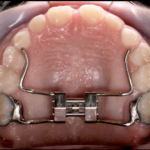
Posterior crossbites where the upper molars bite inside the lower molars occurs in around 4% of European children and adolescents and 17% of Americans. Treatment of posterior crossbite typically involves expansion of the upper arch adjustments of occlusal interferences and elimination of the functional displacement of the mandible.
The aim of this Cochrane review update was to assess the effects of different orthodontic treatments for posterior crossbites.
Methods
Searches were conducted in the Cochrane Oral Health’s Trials Register, Cochrane Central Register of Controlled Trials (CENTRAL), Medline, Embase, ClinicalTrials.gov and the WHO International Clinical Trials Registry Platform. This was supplemented by hand searches of the journals, European Journal of Orthodontics; American Journal of Orthodontics and Dentofacial Orthopedics; Orthodontics and Craniofacial Research; The Angle Orthodontist; British Journal of Orthodontics and Journal of Orthodontics; Progress in Orthodontics.
Two reviewers independently and in duplicate., selected studies extracted data and assessed risk of bias. Dichotomous data was summaries using risk ratios (RR) and 95% confidence intervals (CIs) unless there were zero values in trial arms when odds ratios (ORs) were used. Continuous data was summarised with used mean differences (MD) with 95% CIs. Fixed effect models were used for meta-analyses and the GRADE approach to assess the certainty of the evidence
Results
- 32 RCTs involving 1410 patients were included.
- 15 studies were at high risk of bias, 8 studies at low risk of bias and 8 at unclear risk.
Intervention versus observation
- In children aged 7 to 11 years the quad-helix was beneficial for posterior crossbite correction compared to observation OR = 50.59 (95%CI: 26.77 to 95.60) [3 studies, 149 patients, high-certainty evidence]. This resulted in higher final inter-molar distances MD = 4.71 mm (95%CI: 4.31 to 5.10) [3 studies, 146 patients, moderate-certainty evidence].
- Expansion plates were also beneficial for posterior crossbite correction compared to observation OR = 25.26 (95%CI: 13.08 to 48.77), [3 studies, 148 patients, high-certainty evidence]. Resulting in higher final inter-molar distances, 3.30 mm (95%CI :2.88 to 3.73), [3 studies,145 patients, moderate-certainty evidence] and higher inter-canine distances MD = 2.59 mm (95%CI: 2.18 to 3.01), [3 studies, 145 patients; moderate-certainty evidence].
- The Hyrax is probably effective for correcting posterior crossbite compared to observation, OR = 48.02 (95%CI; 21.58 to 106.87), [93 patients, 3 studies; moderate-certainty evidence]. 2 studies (72 patients) in adolescents (12 to 16 years) found that Hyrax increased the inter-molar distance compared with observation, MD = 5.80 (95%CI: 5.15 to 6.45), [moderate-certainty evidence].
Intervention A versus intervention B
- In children, compared to expansion place the quad-helix was more effective for posterior crossbite correction, RR = 1.29 (95%CI: 1.13 to 1.46), [3 studies, 151 patients, moderate-certainty evidence]: –
- final inter-molar distance MD= 1.48 mm (95%CI: 0.91 mm to 2.04 mm), [ 3 studies, 151 participants; high-certainty evidence].
- inter-canine distance MD =0.59 mm higher (95%CI: 0.09 mm to 1.08 mm), [3 studies, 151 patients, low-certainty evidence) and
- length of treatment MD = −3.15 months, 9(5% CI −4.04 to −2.25), [3 studies, 148 participants; moderate-certainty evidence].
- There was no evidence of a difference between Hyrax and Haas for posterior crossbite correction, RR = 1.05, (95%CI: 0.94 to 1.18), [3 studies, 83 patients; moderate-certainty evidence] or inter-molar distance, MD= −0.15 mm (95%CI: −0.86 mm to 0.56 mm) [2 adolescent studies, 46 patients; moderate-certainty evidence].
- There was no evidence of a difference between Hyrax and tooth-bone-borne expansion for crossbite correction RR= 1.02 (95%CI: 0.92 to 1.12); [ 3 studies, 120 patients; low-certainty evidence]
- There was no evidence of a difference between Hyrax with bone-borne expansion for posterior crossbite correction RR =1.00 (95%CI: 0.94 to 1.07), [2 adolescent studies, 81 patients; low-certainty evidence].
Conclusions
The authors concluded: –
For children in the early mixed dentition stage (age 7 to 11 years old), quad-helix and expansion plates are more beneficial than no treatment for correcting posterior crossbites. Expansion plates also increase the inter-canine distance. Quad-helix is more effective than expansion plates for correcting posterior crossbite and increasing inter-molar distance. Treatment duration is shorter with quad-helix than expansion plates.
For adolescents in permanent dentition (12 to 16 years old), Hyrax and Haas are similar for posterior crossbite correction and increasing the inter-molar distance.
The remaining evidence was insufficient to draw any robust conclusions for the efficacy of posterior crossbite correction.
Comments
The previous version of this Cochrane review published in 2014 (Dental Elf – 15th Aug 2014) included 14 RCTs compared with the 32 RCTs in this latest version. However only 11 could be pooled in meta-analyses as they were single studies or not comparable in addition only 8 studies were assessed as being at low risk of bias. The review provides moderate to high quality evidence in support of expansion plate and the quad-helix device compared to no treatment and the quad-helix is more beneficial than the expansion plate. There is also some evidence that there may be no difference between the Haas or Hyrax appliances. Evidence for other devices was of low certainty consequently additional RCTs are needed to assess the best treatment for crossbites in children, adolescents, and adults. Trails need to be of adequate size well designed conducted and reported following the CONSORT statement and preferably use common outcome sets (COMET) to facilitate future reviews.
Links
Primary Paper
Ugolini A, Agostino P, Silvestrini-Biavati A, Harrison JE, Batista KB. Orthodontic treatment for posterior crossbites. Cochrane Database Syst Rev. 2021 Dec 24;12(12):CD000979. doi: 10.1002/14651858.CD000979.pub3. PMID: 34951927; PMCID: PMC8709729.
Other references
Cochrane Oral Health Blog – Are braces effective for treating crossbite (top back teeth biting down inside the bottom back teeth)?
Dental Elf – 15th Aug 2014
Dental Elf – 23rd Dec 2011
Picture Credits
By Ian Furst – Own work, CC BY-SA 4.0
